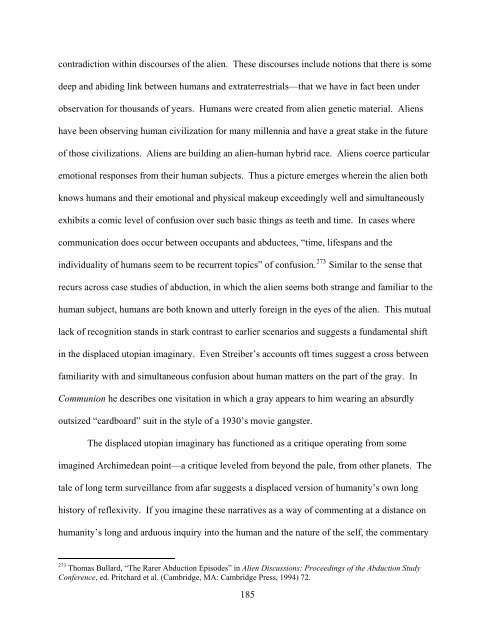A Genealogy of the Extraterrestrial in American Culture
A Genealogy of the Extraterrestrial in American Culture
A Genealogy of the Extraterrestrial in American Culture
You also want an ePaper? Increase the reach of your titles
YUMPU automatically turns print PDFs into web optimized ePapers that Google loves.
contradiction with<strong>in</strong> discourses <strong>of</strong> <strong>the</strong> alien. These discourses <strong>in</strong>clude notions that <strong>the</strong>re is some<br />
deep and abid<strong>in</strong>g l<strong>in</strong>k between humans and extraterrestrials—that we have <strong>in</strong> fact been under<br />
observation for thousands <strong>of</strong> years. Humans were created from alien genetic material. Aliens<br />
have been observ<strong>in</strong>g human civilization for many millennia and have a great stake <strong>in</strong> <strong>the</strong> future<br />
<strong>of</strong> those civilizations. Aliens are build<strong>in</strong>g an alien-human hybrid race. Aliens coerce particular<br />
emotional responses from <strong>the</strong>ir human subjects. Thus a picture emerges where<strong>in</strong> <strong>the</strong> alien both<br />
knows humans and <strong>the</strong>ir emotional and physical makeup exceed<strong>in</strong>gly well and simultaneously<br />
exhibits a comic level <strong>of</strong> confusion over such basic th<strong>in</strong>gs as teeth and time. In cases where<br />
communication does occur between occupants and abductees, “time, lifespans and <strong>the</strong><br />
<strong>in</strong>dividuality <strong>of</strong> humans seem to be recurrent topics” <strong>of</strong> confusion. 273 Similar to <strong>the</strong> sense that<br />
recurs across case studies <strong>of</strong> abduction, <strong>in</strong> which <strong>the</strong> alien seems both strange and familiar to <strong>the</strong><br />
human subject, humans are both known and utterly foreign <strong>in</strong> <strong>the</strong> eyes <strong>of</strong> <strong>the</strong> alien. This mutual<br />
lack <strong>of</strong> recognition stands <strong>in</strong> stark contrast to earlier scenarios and suggests a fundamental shift<br />
<strong>in</strong> <strong>the</strong> displaced utopian imag<strong>in</strong>ary. Even Streiber’s accounts <strong>of</strong>t times suggest a cross between<br />
familiarity with and simultaneous confusion about human matters on <strong>the</strong> part <strong>of</strong> <strong>the</strong> gray. In<br />
Communion he describes one visitation <strong>in</strong> which a gray appears to him wear<strong>in</strong>g an absurdly<br />
outsized “cardboard” suit <strong>in</strong> <strong>the</strong> style <strong>of</strong> a 1930’s movie gangster.<br />
The displaced utopian imag<strong>in</strong>ary has functioned as a critique operat<strong>in</strong>g from some<br />
imag<strong>in</strong>ed Archimedean po<strong>in</strong>t—a critique leveled from beyond <strong>the</strong> pale, from o<strong>the</strong>r planets. The<br />
tale <strong>of</strong> long term surveillance from afar suggests a displaced version <strong>of</strong> humanity’s own long<br />
history <strong>of</strong> reflexivity. If you imag<strong>in</strong>e <strong>the</strong>se narratives as a way <strong>of</strong> comment<strong>in</strong>g at a distance on<br />
humanity’s long and arduous <strong>in</strong>quiry <strong>in</strong>to <strong>the</strong> human and <strong>the</strong> nature <strong>of</strong> <strong>the</strong> self, <strong>the</strong> commentary<br />
273 Thomas Bullard, “The Rarer Abduction Episodes” <strong>in</strong> Alien Discussions: Proceed<strong>in</strong>gs <strong>of</strong> <strong>the</strong> Abduction Study<br />
Conference, ed. Pritchard et al. (Cambridge, MA: Cambridge Press, 1994) 72.<br />
185















